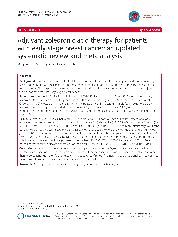摘要
Background: Zoledronic acid is a potent inhibitor of osteoclast-mediated bone resorption and has been widely used in bone metastasis malignancies and postmenopausal osteoporosis as a preventive therapy against skeletal-related events. The purpose of this study was to evaluate the clinical outcome of zoledronic acid as an adjuvant therapy for patients with early stage breast cancer. Patients and methods: Entries in the PubMed and EMBASE databases up to 12 July 2013 were systematically reviewed. Online abstracts from the proceedings of the Annual Meetings of the American Society of Clinical Oncology (ASCO) (1992-2013) and the San Antonio Breast Cancer Symposium (SABCS) (2004-2013) were also reviewed. Primary endpoints included overall survival (OS) and disease-free survival (DFS), while secondary endpoints included bone metastasis-free survival (BMFS), distant metastasis-free survival (DMFS), and fracture-free rate (FFR). Results: A total of eight studies including 3,866 subjects and 3,864 controls met our search criteria and were evaluated. The use of zoledronic acid was found to improve OS (relative risk (RR), 0.88; 95% confidence interval (CI), 0.77-1.01; p-value = 0.06) and DMFS (RR, 0.77; 95% CI, 0.60-1.00; p-value = 0.05). Furthermore, statistically significant benefits were associated with BMFS (RR, 0.81; 95% CI, 0.66-0.99; p-value = 0.04) and FFRs (RR, 0.75; 95% CI, 0.61-0.92; p-value = 0.007). In contrast, there was no significant difference in DFS with the application of zoledronic acid (RR, 0.88; 95% CI, 0.72-1.09; p-value = 0.24). Sensitivity analysis further identified the improvement of 5-year OS for the adjuvant zoledronic acid therapy in early stage breast cancer patients (RR, 0.86; 95% CI, 0.75-0.99; p-value = 0.03), while a borderline statistically significant benefit was observed for 5-year DFS (RR, 0.90; 95% CI, 0.81-1.00; p-value = 0.06). Conclusion: Zoledronic acid as an adjuvant therapy appears to improve the 5-year OS rate for early stage breast cancer patients, and was associated with a protective effect for the bone metastases and fractures evaluated in more than 7,000 patients. However, further research is needed to confirm our findings, and sub-group analyses according to menopause status or hormone status may provide further insight.
- 出版日期2013-10-23
- 单位重庆医科大学
